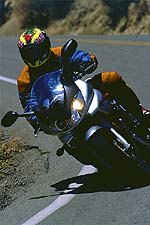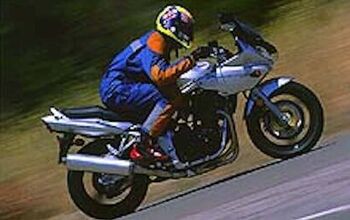2001 Suzuki Bandit 1200S - Motorcycle.com
Los Angeles, July 18, 2000 -- A normal part of any new bike intro is a photo session somewhere around the mid to late portion of the day's ride. This particular intro saw Tom Riles behind the lens, pointing away at various riders taking their turns through bends in the road until, in one particularly off-camber and nasty corner, Master Riles got the living stuff scared out of him when we came towards him at a high rate of speed sounding like we were towing an anvil along behind us; complete with sparking light show and a little bob-and-weave of the chassis to add just a little more drama to the moment.
No worry, Tom, we're professionals; and that's just the foot pegs carving a little niche for themselves in the pavement while the
What's so impressive about this Bandit compared to previous iterations is not so much what it does well, as much as what it doesn't do:
When we sampled Suzuki's Bandit 600S a few months ago we were please with the bike, but not overly impressed. It was a good commuter and could pull off mild sport duty pretty well, but the motor was a bit on the wheezy side and, paired with an obnoxious buzz, not all that fun to do the highway drone on should there be ample mileage between your chosen set of curves. We expected similar things from the 1200 but, once again Suzuki has surprised us with a bike that is, pardon the cliche, more than the sum of its parts.
The design goal for the new Bandit was to, "maintain the Bandit's originality and distinctive character while refining performance and features." There was a paradox created in the execution of these parameters in that the design team wanted not only sportier performance, but a comfortable ride as well; the two of which rarely, if ever, go hand in hand.
"Yeah, baaaby. This bike is all about me. I am this bike on so many levels it's scary."
Suzuki hopes that they addressed most of the complaints from earlier models with this Year 2001 Bandit 1200S, starting with the larger fuel tank capacity. The new model carries 20 liters which is a one liter increase over the previous model. While this is definitely a good thing in the long run, a few of us on the intro noted a slightly more top-heavy feel to the (fully fueled) bike when compared - seat of the pants - to the previous version. As for the other improvements, there were fewer side-effects than with the larger gas tank.
The main targets with the motor were to improve what was not only sluggish throttle response, but carburetion that was excessively lean and was sometimes surge-happy when cruising along at certain RPM. Along the way, Suzuki felt it wise to empower the old mill with a few more foot-pounds of torque as well as some more horsepower at low and mid-range speeds, and who are we to argue with a notion like that?
Again, a caveat in that Suzuki - while addressing the lean surging - would attempt to clean up emissions even further, seemingly leading to even worse surging. But Suzuki was able to attain their lower emissions goal while not only eliminating most - if not all - of the surging and what was previously a rather wicked flat spot in the power with the help a new throttle position sensor (TPS) on the Mikuni BSR36 carburetors. Mated with ignition timing maps which are different not only from the previous year's version, but from each other as well. The number two and three cylinders and the number one and four cylinders have different maps that vary dependent upon throttle opening as well as engine RPM.
Adopting a similar system to that of Yamaha's Air Induction System (AIS), Suzuki has been fitting its Pulsed Secondary Air Injection System (PAIR) to California-bound Bandits, Hayabusas and GSX-Rs, that will now be standard issue on all Bandits in all markets. The PAIR system does not effect power output but it does add a few extra pounds to a machine which could already stand to lose a few pounds.
The wheelbase has been shortened by five millimeters and now measures 1,430 mm, helped by the reduction in trail by three millimeters to 104 mm. To quicken steering the caster has been decreased by 0.2 degrees, and to help keep rider weight and overall mass lower to the tarmac, the seat height was reduced by 45 mm to 790 mm. This seat provides not only wonderful support for burning through consecutive tanks of gas, but also enough firmness to allow mobility when shifting body weight in the twisties. Unfortunately, the seat cover looks like something off of a mid-eighties Volvo station wagon; but it goes well with the metallic silver paint on our bike whose enormous glitter flakes remind us of this girl who dances at this seedy little joint down the road from our offices.
More by Motorcycle Online Staff

































Comments
Join the conversation